|
Art
History as the image of inner spiritual impulses.
Part
of 13 lectures given in Dornach between 9 and 29 October
1917.
Lecture by Rudolf Steiner
Part
4: Lecture 11
The battle of individual artistic representation amidst the
demands of traditions from the South and those from the East
(Icons) during the important incisive time period between the
decline of the 4th and the rise of the 5th post-Atlantean
epoch.
ICONS, MINIATURES, GERMAN MASTERS
Dornach, 15 October 1917
I
think that it is good right now to become familiar with the
most varied areas of life and the laws of existence which I
have been referring to during these lectures. I want to say
these laws of existence take on an importance in their realm of
the spiritual life, an importance of being, which up to now has
frequently not been taken into account in world opinion.
Particularly in our present time it is imperative to totally
understand the current 5th post-Atlantean epoch in
which we stand, with all its peculiarities, in order for us to
become ever more and more conscious of how affective we are
within it. You know of course that we consider the beginning of
the 5th post-Atlantean epoch beginning at the start
of the 15th Century, from about 1413 onward. The
beginning of the 15th Century was a significant,
profound, incisive point for western humanity. The creation of
such an about-turn which came about didn't happen all at once,
it was preparatory. In the first moments of this epoch one only
sees a gradual expansion. Old patterns from the earlier epochs
transform into the new one and so on. Preparations were being
made for a long time which were only really being experienced
as a mighty reversal at the start of the 15th
Century.
If
we want to consider another strong western historical impact in
the centre of the Middle Ages, we may look at the rule of
Charlemagne from 768 to 814. If you wish to visualize
everything which happened in the West to the furthest
boundaries up to the time of Charlemagne, you will have
difficulties with this self-visualization. For many observers
of history today such difficulties do not exist because they
all shear it under the same comb. Only for those who want to
look at reality, will such deep differences exist. It becomes
quite difficult for people in today's world of experiences and
impressions to reach a concept about the completely different
condition of life in Europe up to the time of Charlemagne and
beyond. We may however say that after Charlemagne, in the
10th, 11th and 12th Centuries
a time began in preparation of our own epoch, the
5th post-Atlantean epoch. Up to the time of
Charlemagne old relationships actually flowed which in our
present day, as we have already said, we can't have a true
imagination. Then again preparations were beginning for a new
epoch, and in these three centuries, the 10th,
11th and 12th — it started in the
9th already — events took place in Europe in all
areas of life producing forces which were expressed later,
particularly in the 15th century.
One
can say these centuries just mentioned was a time for
preparation but people today are hardly inclined to refer to
this just as little as they will say Rome is in control of
European affairs. The papacy in the time from the
9th century, before the middle of the 9th
century where the ruling of Europe was so vigorously taken
under control, where all relationships effectively extended,
must not be imagined as the same effective papacy in a later
century or even today. It can rather be said that in those
times the papacy knew instinctively what the most important
areas of life needed, in west, central or southern Europe. I
already pointed out last time that the oriental culture was
gradually pushed back; it had to wait in eastern Europe, in
Byzantianism, in Russianness. There it waited indeed, waited
right up to our present time.
General observations can develop particular clarity in those
areas which, in the broadest sense, one can refer to as
artistic. If you want an idea about what had been pushed back
at the time to the East, what the west, central and southern
Europe should not acquire, if you want to reach an
understanding about it, then compare it with a Russian
icon:
245
Russian Icon: The God's mother by Vladimir (Moscow, Historical
Museum)

245a
Raphael: The Madonna of the Chair (Madonna della Sedia)
(Florence, Palazzo Pitti)

In
the picture of the Virgin Mary of the East is an echo of what
had been pushed back into the East at the time. In such a
picture quite another spirit holds sway than can ever be found
reigning in western, southern and central art; it is something
quite different. Such an icon picture still today presents an
image which has been born directly out of the spiritual world.
If you imagine it in a lively manner you can't imagine a
physical space behind the Russian Madonna image. You can
imagine that behind the picture is the spiritual world and out
of the spiritual world this image has appeared: just so are the
lines, so is everything in it. When you take the basic
character of this image as it is born out of the spiritual
world then you have exactly that which had been held at a
distance in the 9th Century from western, southern
and central Europe:
246a
194 Raphael: The Sistine Madonna: The Madonna with the Child
(Dresden, Zwinger)

246
The Italian Icon: Madonna with the child, image with miraculous
power “Maria Schnee” — Madonna of snow.
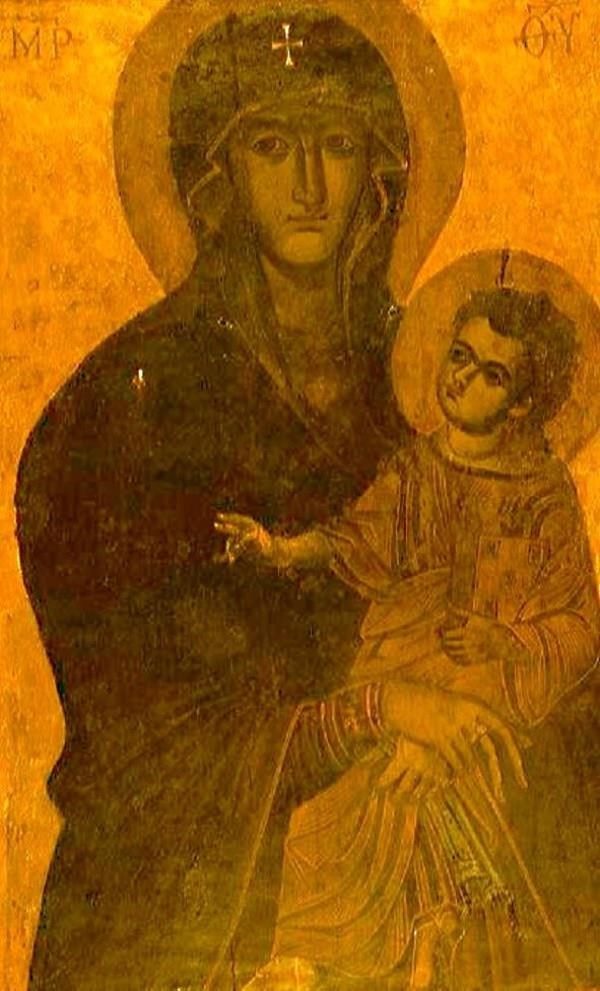
Why? Such things should be thoroughly and objectively
considered historically. Why did this have to be held back?
Simply on the grounds that the nations of Europe — central,
western and southern Europe — had completely different soul
impulses which were not in the position to understand humanity
out of original elementary nature, this was being pushed back,
stopped in the East. The nature of the western European soul
was quite differently focussed.
When this which was being pushed back to the East was
transplanted into central, western and southern Europe, it
could only remain external, outside the east of Europe; it
could never grow together with the central, western or southern
European soul distinctions. An area had to be created in
western, southern and central Europe, an area for what
gradually wanted to come out of the depths of the very folk
soul itself.
I
would like to say Rome, in actual fact, understood this with
genial instinct. With disputes regarding dogmatism showing
quite a different character, the content of dogma disputes is
not the real story; the content of these disputes is merely the
final spiritual expression. It goes much further. Among other
things it was about what I have just been characterising for
you. So we see that from the 9th Century and into
the next centuries Rome worked ever more strongly for a space
in Europe where the real striving of the folk souls could
unfold. The striving of the folk souls also appeared in greater
clarity.
You
see, when you focus on what could have been brought to the fore
if the eastern influence had not been pushed back but could
stretch over Europe — Charlemagne made a large contribution -
if it had stretched over Europe then Europe, as I've already
mentioned, would have made available certain observations of
representations which speak directly out of the spiritual
world. This did not happen, firstly because Europe had to
prepare itself for the materialistic 5th
post-Atlantean period which was prepared most intensely in
central Europe. Interest centred mainly on everything other
than what came directly out of the spiritual world like line,
form and colouring. Humanity was interested in something
different. Above all there was an interest in Europe for
contemporary events, for reporting and for results. By studying
individuals, singled out in humanity, you realize they have
positioned themselves in the course of historic, relatable
events. The 10th, 11th, 12th
Centuries can also be called the Germanic Roman Empire because
from Rome the capacity was created, a capacity which spread for
an interest in relating stories, an interest in the working of
time and for conceptualising a particular form set in time.
You
see, this is again a different viewpoint from the viewpoint I
indicated in similar lectures in previous years. This
cooperation of the central European empire with the Roman
church and its spread is an inner image of the way the
5th post-Atlantic epoch prepared central Europe at
the time. From this it is clear that central Europe prepared
itself in this period with very little interest for spatial
educational art. Constituted informative art became borrowed -
just remember the presentation which I gave you in previous
years — borrowed from what came over from the East, spread, one
might say, through to the very joints of principal interest.
What shot up out of the folklore itself was being told. The
content which was to be told had to be taken out of national
character, intimately connected with nationality.
You
can encounter amazing images of central European life, life in
the areas of the Rhine, the Donau and the northern coastline in
the depiction of the songs of the Nibelungen, the Walthari and
`Gudrun'. The manner and way in which these writings are
presented indicate their obvious interest in events of the
time. Look how in the time of Charles the Great when the poem
`Heiland' originated, the stories of the Gospels are woven into
the poem with central European characters, characters extracted
from biblical events and placed directly into the central
European interests of the `Heiland'. It had to be born out of
the life of the European folk soul. Through this the eastern
tradition, which cares little for the temporal and historical,
was pushed back. For this reason, it was pushed back. If we
observe how these concerns of the European nations rise from
deep underground and reach the surface, then it is often only
possible, and with difficulty, to really penetrate into the
depth of feeling, into the deep soul experience which the
European human spirit connected to in its own deepening
encounter with the essential spiritual events. One might say,
that which was pushed back to the East from spatial infinity
and its manifestation out of space, which had to appear
superficially in central Europe should reappear directly out of
the human souls themselves, out of the depths of the soul, not
out of the widths of space — but out of the depth of souls.
The
mysterious prevailing of soul depths under the surface of
direct observation was already something living at that time in
human souls. During the centuries we've been talking about,
people were instinctively permeated with the knowledge that
their souls had in the depths of their being secret impulses,
appearing only sometimes at celebratory moments in their soul
experiences. Life seemed deeper than what the eyes could see,
the ears could hear and so on; something unfathomable rose from
soul depths as a profound experience. I could say we experience
an echo of this kind of thing when we hear something as
beautiful as the poetry of Walthers von der Vogelweide,
who to some extend created an ending to a purely linguistic
age, an age when the ability to depict formless manifestations
in soul depths in a pictorial manner had not yet developed. In
these soul depths we are stirred when we allow Walthers von der
Vogelweide's small poem to work on us, where he speaks about
his own life in retrospect. Maturing as a man when knowledge
grew in his soul and light fell on his soul depths from which
knowledge had previously appeared as mysterious waves in a
dream, now appeared in a mood, he expressed as follows:
“Oh, whereto did all my years disappear!
I dreaming my life or is it real?
What appears for real, was it illusion's face?
I've slept so long and didn't even know it.
I've been woken and all is as unfamiliar
once was familiar, like my own hand.”
Thus speaks Walther von der Vogelweide at the end of the three
long centuries, the 10, 11, 12th centuries, the
epoch in which the Holy Roman Empire blossomed at the close of
this time period. It was the period of time in which the
interest for current events developed. Art demanded expression,
images were to express events happening and going to happen in
central, western and southern Europe. A glance to the East
gives the impression of existence and peace, of a quiet
contemplation out of the spiritual world. Events directly
taking place here, born in the human soul, binding the soul
with the greatest of all, the most mysterious, all this was
eager to be represented in a pictorial manner. Fertilization
from the South was needed anyway, where echoes of all the
traditions having come from the East were still maintained.
Bringing events to expression was the primary goal.
In
this way striving in art was contained in the West, one might
say, in two opposing streams, for certainly the representation
of existence was pushed back East, but only pushed back — many
things remained. Above all, something remained which can be
observed in the East where strict rules determined the
depiction of the icons, and old rules were being adhered to,
where no violation was allowed through lines, expression, and
so on. All this was transplanted into the West and alongside
this was the requirement for everything experienced in the
surroundings, united with traditions coming into central Europe
from the South. Naturally depictions with this requirement
firstly appeared in primitive, simplistic images according to
biblical narratives, Bible stories. Only at the beginning of
the next three centuries, the 13th, 14th
and 15th did a power, one could call it, rise up out
of Central Europe which could depict image-rich pictures. This
power is thanks to specific facts; facts which during these
centuries, the 13th, 14th and
15th, expanded and matured over the whole Central
and Southern Europe as something one could call city
domination, the blossoming of rural development. The cities, so
proud at the time of their powerful autonomy, developed the
particular powers of their folk in their midst. Such cities
were not uniform, either as the old Germanic Roman Empire which
was in decline, nor uniform as in the later state communities,
because these cities were autonomous and could develop their
individual strength according to the needs of the specific
land, lifestyle and place. One doesn't understand the times of
the 13th, 14th and 15th
Centuries if one does not again and again glance at the
blossoming of city freedom at the time.
Let
us visualize this flowering of city freedom — by roughly taking
the 11th to 15th centuries — and consider
what this freedom in the cities discovered in relation to art
impulses. Some traditions originating from Rome remained. The
main issue had been pushed to the East; yet some traditions
remained behind, traditions of alignment, colour application
and, in relation to facial expression, the eyes and nose had to
be done in a certain way. Yet all of that counteracted with the
aim to represent facts. These battles had two sides, we can see
it here where the artistic element first only dares to appear,
turns from within itself outward, where, I might say, the
trained monk from Rome allows himself to be inundated with the
influence from central Europe, the impulse to not merely depict
biblical events but that the imagery appearing in the Bible,
which are glimpses from the spiritual worlds, are depicted in
such a manner that the Bible itself becomes the very expression
of how people live in daily life. This was now imposed on the
monk in his solitary work. When he paints his miniatures and
represents biblical scenes in a small manner, he must be
accountable on the one side for the remains of tradition and on
the other side, what wants to manifest as life under the
surface.
Today I have two such miniatures to show you from which you
will see, how during the 11th, 12th and
also in the 13th Centuries the battle between
traditional painting and history was still visible in small
paintings.
Look at such a painting from an evangelist representing the
“Birth of Christ” — we considered this image in
previous years.
274
Miniature Birth of Christ and the annunciation to the shepherds
(Cologne, Dom Library)

See
how much you are reminded of the tradition of mere existence.
Consider how still here, I might say, these figures are shown
in such a way which does not reflect how people in an outer
naturalistic reality live but observe how the figures are born
out of the imagination people made up of what the spiritual
worlds were for them. From there the saints, the Christ figure
himself appears; all this came out of another world. Behind the
surface of the painting we can only imagine the spiritual world
— of course pictorially and radically spoken.
Above all there is no trace of naturalism. Observe how there is
no trace of perspective, no trace or an attempt in this
painting to somehow represent space — everything is on the
surface, all but intellectual representation. Despite all this,
when you look at the single figures, you experience the urge of
something wanting to be expressed. You will notice there are
two things fighting with one another. Look at the face on the
right and the one on the left and you will see how the eyes,
maintaining something from tradition by the person in his monk
cell had a thought from his teaching that somehow or other eyes
had to be done, this and that way the expression had to be done
— but he battled with it, he adjusted to a certain extent the
view of the situation to the events.
Even in these tiny paintings made in the gospels, in books of
the bible, this battle of the two elements can be seen in a
struggle. Besides this you see again, for example in Cimabue
even more, how existence was expressed in the oriental form.
How we are absolutely reminded of the angel figures above -
which already appear when it comes to Cimabue as an oriental
echo of the conception of the pictorial — as a proclamation out
of the spiritual world itself, as an experience of being, not
of historical events!

Another test is the second picture, which I have prepared,
which comes from the Trier Gospels:
248
Miniature of Christ's birth: Proclamation to the Shepherds
(Egberti Codex Trier)

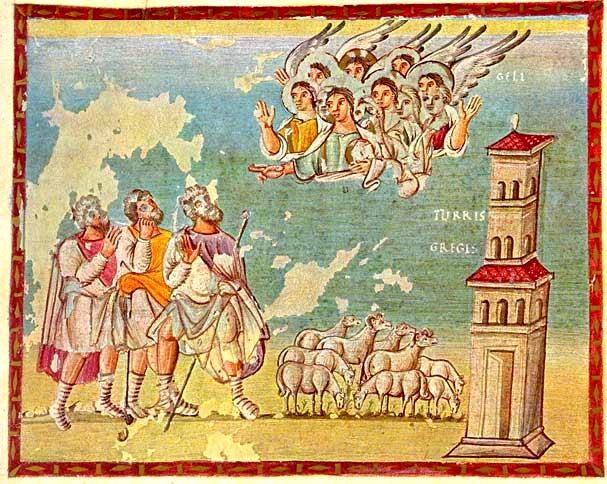
Here we see the proclamation to the shepherds, above is
Christ's birth. When you take this shepherds' proclamation of
the angel announcing “Glory in the Heights and peace on
earth to men of goodwill”, when you take this you
discover a mixing of these two impulses.
In
all three of the men's faces we find the endeavour: represent
the facts! On the other side however everything at a distance
is about natural observation; how traditions play into this! I
would like to say, feel how the wings of the angels are in the
book: wings should be depicted in such a manner that they are
at an angle to the main scene, pointing to both sides, and so
on. You sense the requirement and at the same time sense such a
depiction impinges on the endeavour which can't be achieved
according to the observation of historical events. Sense this
and observe in all of them how little nature observation is
apparent, how there is no trace of spatial application, no
trace of perspective in this image, that everything is, I want
to say, or implied in the place where they are depicted due to
requirements of how something like this was to be done, teach,
while still substantially in control.
Now
we see how at the end of the three centuries of the Germanic
Roman Empire the impulse from the establishment of cities to
depict history and unite it with the requirements of
experiential representation, how this urge in Central Europe
came to a sudden and most beautiful flowering. Cologne is one
of those cities where the city's freedom flowered the most
intensively and at the same time had the possibility, through
intensive expansion of the Roman Catholic dominance, to take up
traditional design art coming over from the East. No wonder as
a result that just in Cologne the possibility encounters us in
how, in the most wonderful way this comes together, weaving the
two impulses into one another: the one most ancient and revered
tradition depicted — what a Madonna looks like — and the urge
to represent history. How a Madonna had to look like — in the
East was petrified spiritually, majestic, serene, but still,
solidified. It had to wait. Movement was brought in from the
West. The revelation brought in from above, from heaven,
revealed in the Madonna figure, is to be experienced in the
Russian Madonna as magnificently elevated and permeated with
something one can see directly: the greatest beauty possibly
revealed in a human face, the loveliest direct expression of
the ability to love, human friendliness, human goodwill,
everything living in the surroundings lived in an inner
relationship with the revealed figure of the Madonna.
Consider this and then look at the painting done by Master
Wilhelm:
243 238 Cologne Master: Madonna with the Wicken
flower (Cologne, Wallraf-Richartz Museum.)

Here you can see what I actually want to point out: you can see
how an attempt is made to bring life, that means events, into
being in the Virgin Mary depiction. Here individual observation
merges with tradition right into the details, one might say:
old prescriptions were only applicable to attitude, nobility of
form, serenity but not much further than in the expression of
line, thus tradition was already being experienced from
individual observation. This is what we can admire so much in
these masters.
Another painting by the same master:
237
Cologne Master: Saint Veronica with the sudarium/ Veronica's
veil (Munich, Older Picture Gallery)
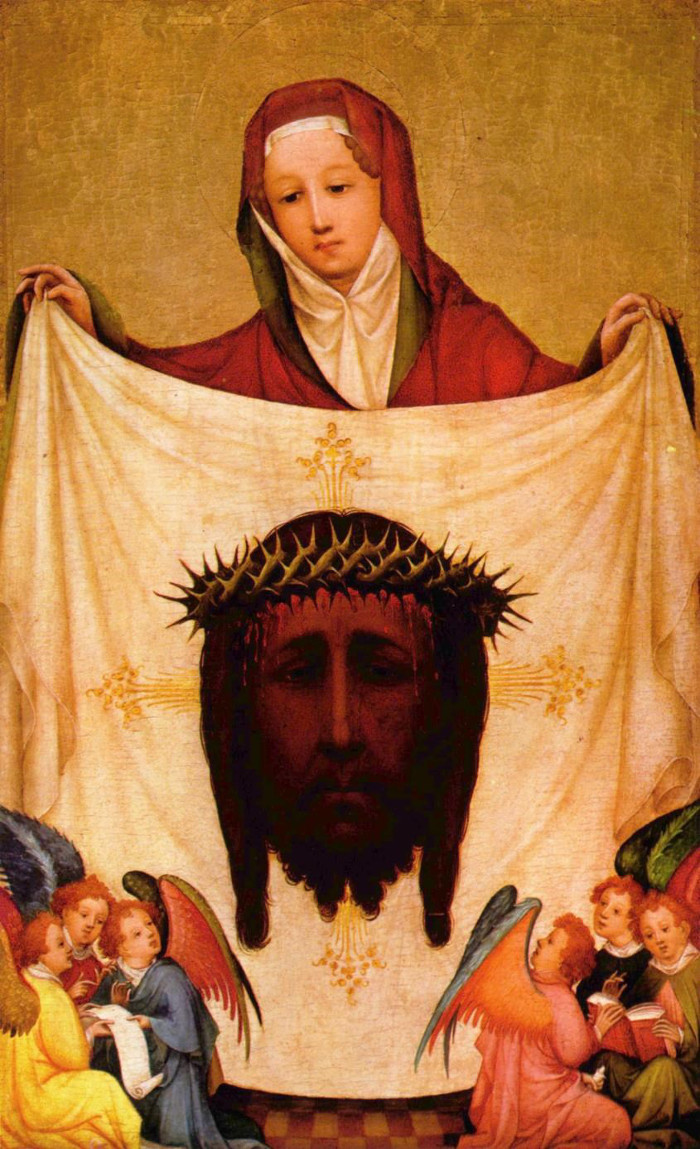
Another painting by the same master ... to indicate what I have
just mentioned, shown in another representation. Consider just
how much has come through the traditional heavenly figure, the
revealed form of the Redeemer's face, of Veronica's face, in
which we can see something revealed directly out of soul
depths. See for yourself how those angel faces looking up are
already individualized! Consider how with this image, as a
result of the individualizing of figures it is no longer
possible to actually imagine heaven behind it. However,
something else is possible. At the back of the image, which
came out of the Eastern inclination (245) we can actually
imagine the spiritual world, something in addition to what the
image presents. Here (237) we can also imagine something else;
we must feel something different from what the image depicts.
We feel much of what has gone before due to knowledge from the
Bible; we feel much of what has resulted, events have been
experienced and what is depicted are scenes from before and
after. Thus there is not something like a spiritual realm
behind it; the experience is of something before and something
afterwards. When the singular is represented — visual art does
this after all — then a single element is lifted out of the
events. This is what we find towards the conclusion of every
time period, towards which Rome out of such a deep
understanding through the three to four centuries created in
the European realm, which wanted to rise out of folklore. The
conclusion appears to us and how this works in Cologne, by such
genial Masters being capable of creating something like
this.
These two intertwining impulses which I have characterised flow
together most remarkably here. Now I would like to indicate
their power which had worked everywhere by showing you a couple
of paintings, starting with Constance who probably learnt from
this and many countries through which he travelled, to arrive
in Cologne and gradually became the follower of so-called
Master Wilhelm, Stephan Lochner. The first is the image
of the Virgin Mary — we know it already:
244 239 Stephan Lochner — Adoration of the Magi
(Köln, Dom)
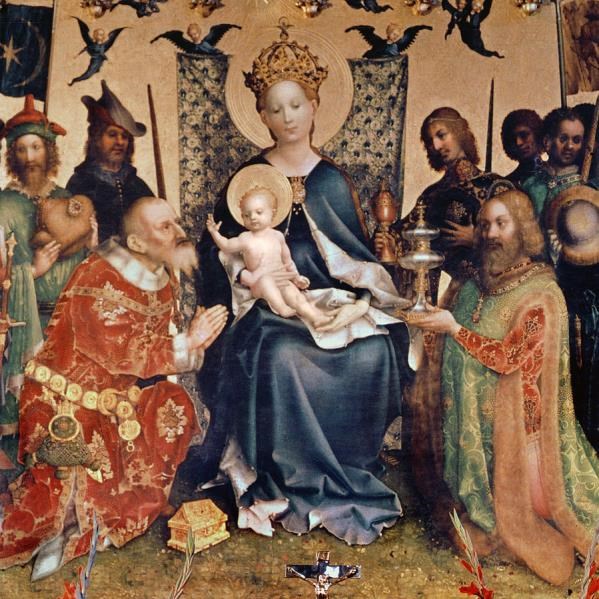

In
this image — you need only compare the single heads — you
already notice the individualizing impulse which is fully
expressed by the figures. This aspiration you can observe. You
hardly see a tendency to use space; everything is on one plane,
you see no possibility of somehow applying perspective, but you
see the yearning, the desire and instinct which can be declared
as events, fixed in the imagery, you see the desire
characterized; you see the past and what will follow
established in the imagery as a scene.
Now
I ask you to look at the two preceding demonstrated paintings
(237,238) by the Cologne masters which appeared when these
masters were blossoming, somewhat around the years 1370 to
1410, therefore directly during the time the fourth
post-Atlantean epoch was coming to a close. This painting by
Stephan Lochner (239) already falls into the fifth
post-Atlantean time. I have shown you images in consecutive
order between the boundaries of the fourth and fifth
post-Atlantean time.
What are the particular characteristics? Don't we see
particular characteristics playing into representations in the
5th post-Atlantean time? Don't we see in the
lowering gaze of Mary, the blessing little hand of the child,
the differences in the right and left figures' expression, in
the individual depiction of the additional figures — do we not
see the characteristics of the 5th post-Atlantean
time — how the character's act in the pictorial representation?
Do we not see how the impact of personality arrives? Above all,
don't we already here see the desire to express the element of
the 5th post-Atlantean time within the imagery, the
most important element for Central Europe: light-and-dark or
chiaroscuro? — How little meaning the distribution of light and
dark had in the old tradition! People lived in light and
shadows but were not observing it, yet were feeling it -
because they experienced light bringing joy, sensing life in
light while darkness sank into rest, in darkness they withdrew
into mysterious soul depths. This inner living in the world in
the souls of single individuals which particularly comes to the
fore in the 5th post-Atlantean time, as well as the
application of chiaroscuro, indicate a distribution of light
masses: in the middle the light is above the Child, we see this
light dividing itself right and left in single masses, becoming
lighter upwards, no longer completed as in earlier version only
in a golden ground, but in a brightness. Thus the encroachment
of individual characters is what we see here; nobody can
actually look at these consecutive elements which I have
demonstrated to you, without becoming aware that something,
albeit quietly, but something new was coming into the
5th post-Atlantean time while the 4th
post-Atlantean epoch faded.
Let
us look once more at the previous Madonna:
243 238 Cologne Master: Madonna with the Wicken
flower — central section.
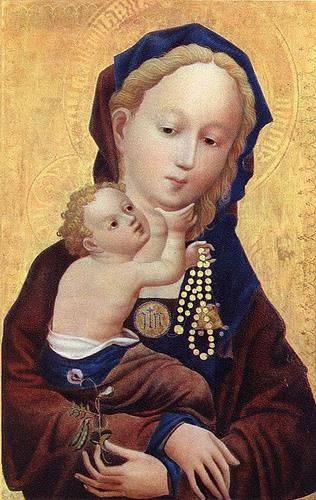
244
239 Stephan Lochner: Adoration of the kings, section:
Madonna

Memorise this child's face well and try to feel how much
tradition still lives in it. Now consider once again another
one:
241
Stephan Lochner: Madonna with the Violet flower (Cologne,
Diocesan Museum)
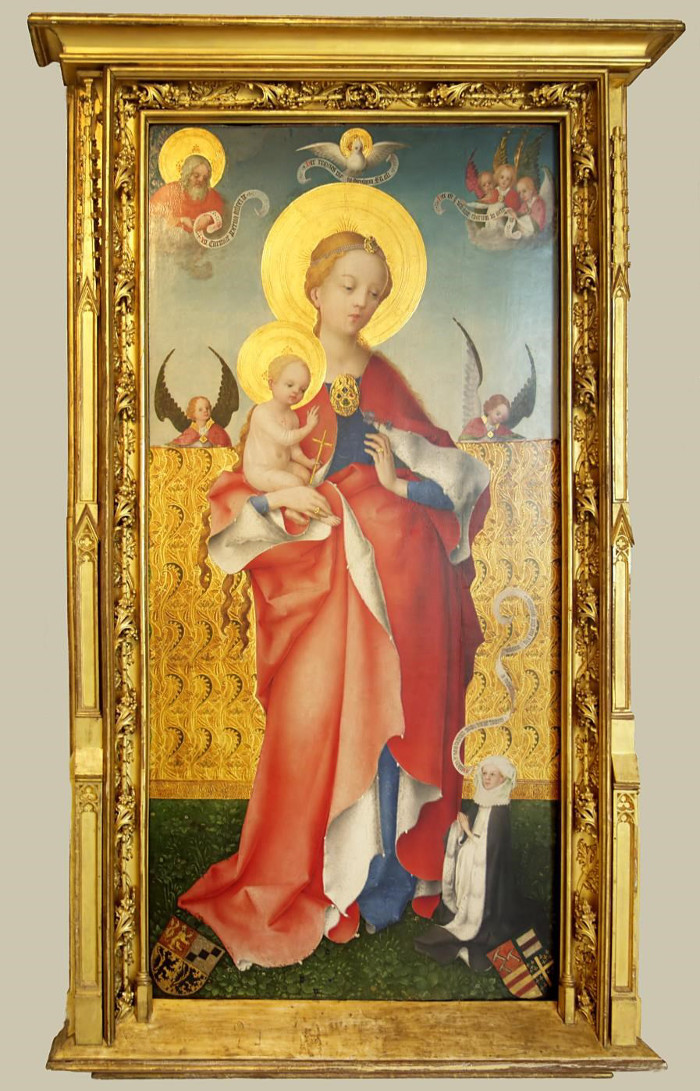
Look at the Madonna and the Child and note how a really new
impulse has entered just like a new impulse does enter with
each individual. Considering the following paintings of Stephan
Lochner. I want to stress that Stephan Lochner originated from
a region where most people were incapable of absorbing
tradition because most of them had the impulse to develop
individualism. It is the region around the Bodensee in the
region of Bavaria, the area of western Austria. Here the tribes
strived out of their folk nature towards individualism, mostly
rejecting tradition. Stephan Lochner was lucky, one might say,
to aim for the Bavarian anticipation of individual expression,
where, despite the striving for the individual, there still
lived the great sublime sacred tradition of olden times. As a
result, his individual impulse, much more pronounced than
Master Wilhelm with his radical individual urge, he connected
to his revolutionary individuation impulse with the smooth,
typically Cologne imaging tradition to produce this image.
For
an artist like Stephan Lochner depicting space within art had
not yet been invented; to depict space could simply not be done
at that time in Cologne, but his soul tried to introduce this
into the images.
Fully within the historical events, completely within
development this can be ascertained by a comparison between the
Virgin Mary image of the West compared to that of the East:
245
Russian Icon: the Mother of God by Vladimir (Moscow, Historical
Museum.)

Look at the next image:
242
Stephan Lochner: Madonna in the rose arbour (Cologne,
Wallraf-Richartz-Museum)
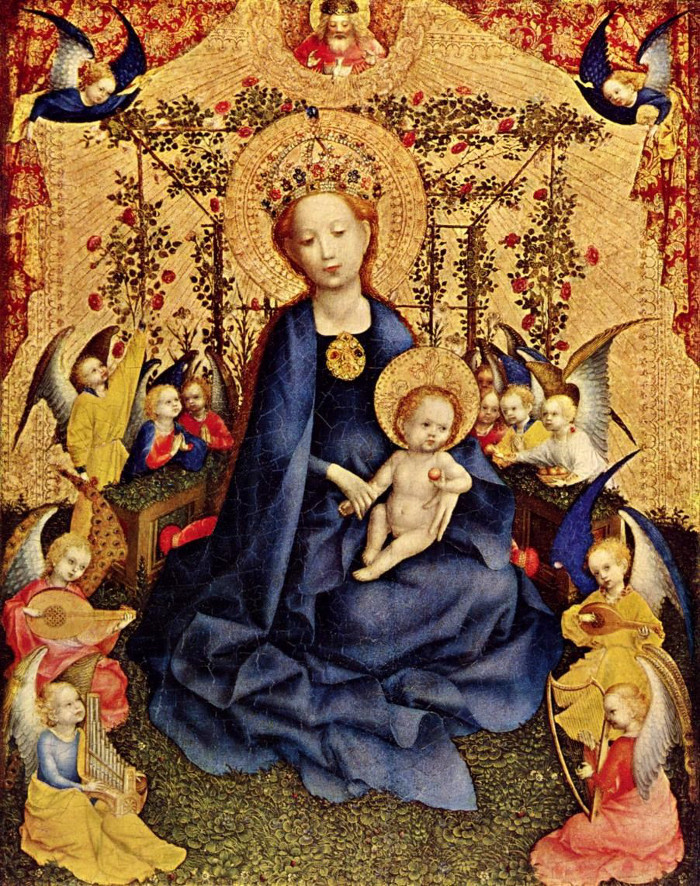
... which you also know already; look at it particularly in the
way the specific fits into the general, so typical in Stephan
Lochner's work, how the dark and light come to the fore even if
there is no continual intention of capturing space, to indicate
perspective, but in the chiaroscuro we see another kind of
spatial capture than that of perspective. The perspective is
more to the South, one could say: invented by Brunellesco — I
have explained this to you in previous years.
And
now …
240
Stephan Lochner: Christ on the Cross (Nurnberg, Germanic
Museum)

...
in which you see there is no trace yet of composition and how
here also, where the depiction would have insisted on a study
of space, there is nothing about space, and how on the other
side an attempt is made to depict each of the six accompanying
figures as individuals, with an attempt to individualise the
Redeemer Himself. Please recall the paintings of the Cologne
Masters (237, 238) and compare these with the paintings of
Stephan Lochner (239-242) which we have seen. It can't be
overlooked how deeply this incision imprints on us what lies
between the two: because this incision lies between the
4th and 5th post-Atlantean epochs.
Stephan Lochner attempted to depict soul qualities, but he
looked for representation in nature to find forms which express
the soul. Master Wilhelm still hovered in a supersensible
experience of the soul and his impressions came out of his
inner feelings. He didn't depict them by looking at a model.
Here (237) we still see a reference to the model in order for
the soul itself to identify with it. Master Wilhelm still
expresses his own feelings. Stephan Lochner is already a copier
of nature. This is in fact realism: realism rising. We can
clearly draw the boundaries between these two so divergent
painters, during hardly decades.
So
you see how the laws which we search for in spiritual science
really come to expression in single spheres of life when these
spheres are not taken as unimportant, but with their importance
are led before the soul.
Now
I would like to place this fact once again before your souls,
by introducing two painters who worked more in the South. This
took place in Cologne. Let us look more towards the South, to
Bavaria, Ulm or the Rhine area and we will see the how
conditions appear before and after the incision of the
5th into the 4th post-Atlantean epoch. I
want to present two paintings to you by Lukas Moser, who lived
in the beginning of the 15th Century, who can
certainly be counted as being from the 4th
post-Atlantean time.
Look at these paintings:
335
Lukas Moser: Ocean voyage of the Saints (from the
Magdalene-Altar, Tiefenbronn Church)
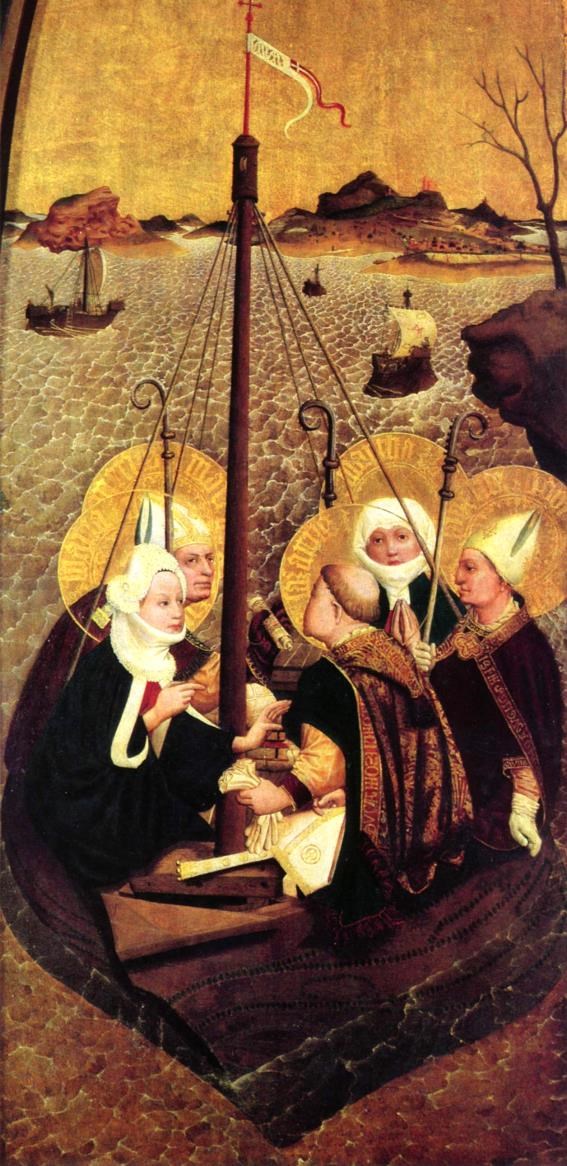
Try
to sense how everything painted in it is done in such a way
that one notices how the painter went through schooling which
insisted: when you place figures beside one another you must
place the one facing you, the other in profile; when you paint
waves, you must paint them like this.
Thus you see the entire play of the sea's waves, not as they
are observed, but “according to the rules”; you see
the figures as prescribed “according to the rules”;
nothing observed, everything composed. This image from the
Tiefenbronn altar thus depicts the ocean voyage of the
saints.
The
following image shows the time of repose, the night time rest
of the same saints:
336
Lukas Moser: Night's rest of the saints. (The Magdalene Altar,
Tiefenbronn Church)

...
A medieval house built on to a church, strongly suggestive that
nothing was observed but everything was painted out of the
head. Look at the sleeping Saint Zedonius: he still wears the
mitre as well as his gloves. It had to be painted according to
the rules where the main interest is located. Consider this as
an ongoing journey, because the saints are taking a trip, they
sail on the sea, they rest at night, it tells a story. Yet it
is presented as set out in an existed image remaining within
tradition. Lazarus resting in the bosom of this mother!
We
can look back to representations of earlier times when we have
such an image in front of us. This is at the point where the
4th post-Atlantean time came to a close. In the West
there were still prescriptions regarding how church imagery
should be painted. Painting was done according to particular
traditional rules. The painters obtained their method out of
tradition: this is what the Saint Zedonius looked like, what
Saint Lazarus looked like, Saint Magdalene and so on; they had
to be painted according to prescriptions, not quite as strictly
as in the East, but still according to the laws. However, he
still had to depict desires, instincts and reveal a story! In
this way the elements swim in and around and battle with the
end of the epoch.
Let
us also look back to the 13th, 12th and
11th centuries. In all the churches strict rules
were set. Each picture had to look the same as another right
through the whole of Christendom, only with a slight variation
in the way the things were ordered. If Saint Zedonius was
ordered, then he was to be painted according to prescription -
that was the tradition.

Let
us now think of the incision of the beginning of the
15th Century and go from Lukas Moser, the last
latecomer of the 4th post-Atlantean epoch, over to
Hans Multscher and see how these painters really already stood
in the beginning of the initial blossoming of the
5th post-Atlantean epoch. Look at these
paintings:
339
Hans Multscher: Birth of Christ (Berlin, German Museum)

...
and you observe how in these paintings the individual-personal
appear, characterising the personality. Moser does not have any
desire to look at nature. Here, (399) you find an artist who
strives to work out of the soul — yet who does not have the
slightest inkling of spatial treatment and above all mixes up
multi-coloured things in relation to space and perspective -
yet who strives to characterise it out of the soul, in such a
manner as if nature itself is characterised in the soul. He
already tries to depict individual figures.
340
Hans Multscher: Christ on the Mount of Olives (Vipiteno
Sterzing, Pallazo Municipale)

It
will become even clearer for you, what I've just been speaking
about, particularly when you look at the three sleeping figures
below. There is already an attempt, first of all, to express
the soul element, but there is also an attempt to depict the
nature of those sleeping. Compare this with what you can
remember about the sleeping saints on their sea voyage (335)
the resting time (336) and then you will realise what a mighty
incision lies between these developments. See how the
light-dark depiction is consciously brought in. Solely
characterized this way and not by working with perspective does
the painter reveal spatial relationships. Perspective is in
fact incorrect because an actual cohesive vanishing point can't
be found in any area of the painting; nowhere can a central
point be found from where the layout is arranged; yet still a
spatial relationship of a certain beauty exists through the
chiaroscuro.
341
Hans Multscher: Burial

Look at this “burial” scene. You find everything,
even in the depiction of the landscape itself, as characterised
by the individual's penetration of tradition: interest in
events without any indication coming out of the spiritual
world.
342
Hans Multscher: Resurrection.
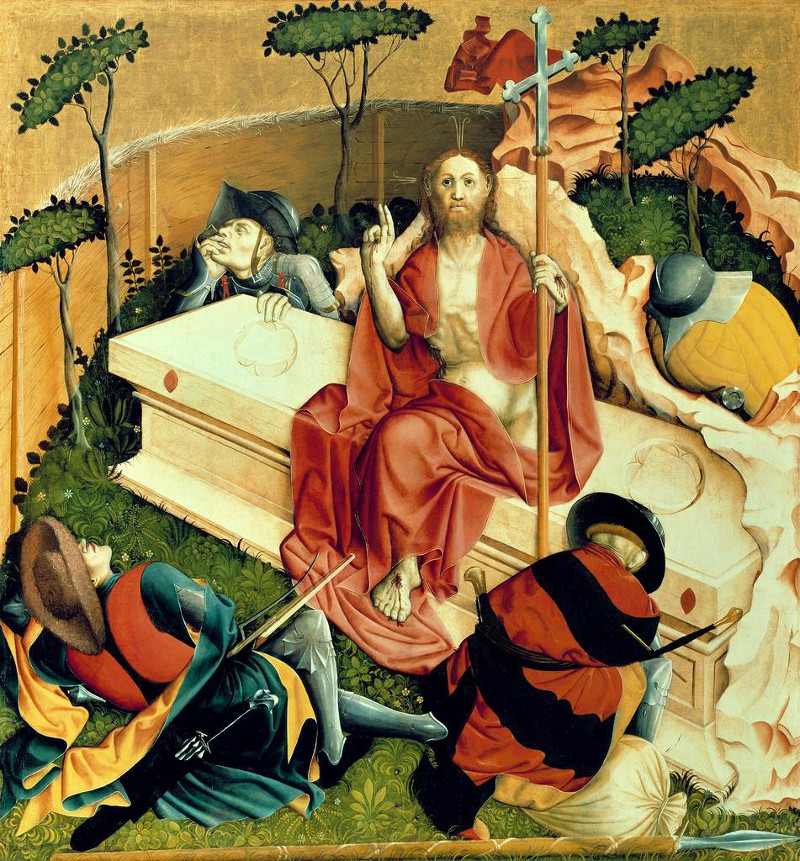
You
see here how particular individualizing elements enter the
entire painting, an attempt is made in a corresponding manner
to represent the guardians, the twist of their bodies enhancing
the individualisation. I ask you to look up, to the left, how
an attempt was made to represent the figure's particular
situation, his unique experience, portraying his peculiar
individual inattentiveness. Try and imagine how the painter
tried to show the front view of the head, how on the right he
characterises the skull of the other guardian, from behind. One
can see how the attempt is made to show individual forms and
also how the chiaroscuro comes in. One can see how through
individualising, depiction of spatial element enters while
perspective is not at all yet clear. You can imagine the point
from which the individual lines go from the characters, but now
you need to think apparently quite far towards the front, where
the coffin is placed and you have to think again about another
reference point — regarding the trees! These are painted in
full frontal positions.
I
wanted to show you how the legitimate developmental impulses I
spoke about already last time in the Italian paintings have a
profound effect and what rises as characteristic in our time,
originating from the 15th Century, can only now be
understood if you clearly take the entire, deep meaning of
every time period, from the beginning of the 15th
Century, which built the boundary between the 4th
and the 5th post-Atlantean epochs.
What transformed itself here had already been living in all the
events and becoming of Europe, but it was pushed back from the
9th Century because Europe was made incapable at
that time; Europe first had to allow something else to take
form out of the depths of its being. Those in the East waited
in the meantime. We should promote an awareness today for what
waited there and what wanted to rise to the surface in the East
because these forces are available, these forces weave into
present day events, still wanting to be active. A clear
understanding of what pulsates through the world, what works in
the world, we need to take possession of, this which is an
urgent requirement for the present time epoch. This I am now
and have repeatedly stressed in the past. Through the
development of the middle age art in its characteristic time
period I wanted to make this clear for you. You see, here we
approach two incisive waves in history: one swell is everything
which came easterly from the south, the other is, I would like
to call it, coming from the depths itself. In these centuries -
13th, 14th and 15th, in the
centuries of freedom in cities, what wanted to rise from soul
depths to the surface was most strongly applicable. Then again
from the 16th Century another setback came -
development rose and fell, oscillated — and then, obviously not
simultaneously, the continuation of what had been started in of
the 15th Century became outwardly visible as I've
indicated to you, on the one side living in van Eyck, on the
other side Dürer, Holbein and so on.
We
see in the lower lands, towards Burgundy on the one side and
Nürnberg on the other, Augsburg, Basel, the results of
what wanted to come as a wave rising from soul depths to
introduce the 5th post-Atlantean period.
I
wanted to introduce only one of the impulses of this
5th post-Atlantean epoch to you. About other
impulses I have various opportunities to speak at the
moment.
|